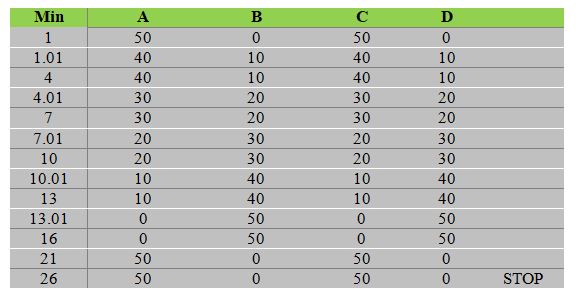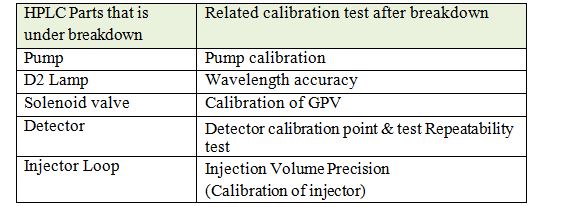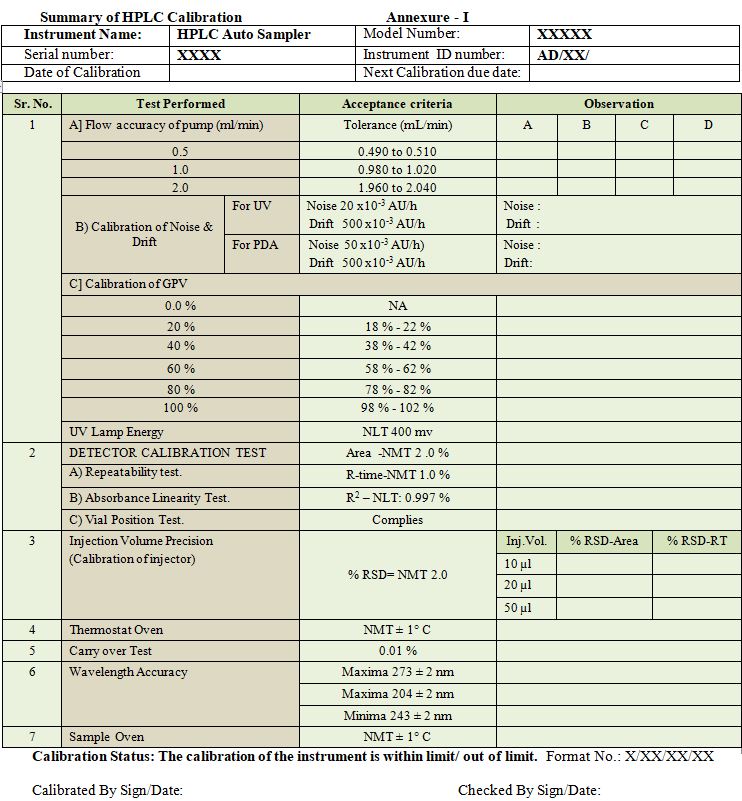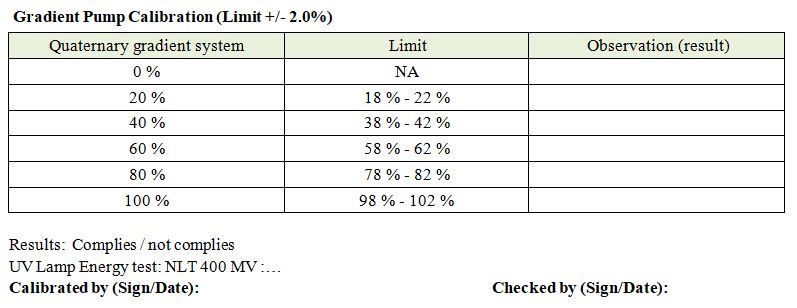1.0 Objective: To describe the written standard procedure for the Operation & Calibration of HPLC LC- 2050C
2.0 Scope: This SOP is applicable for the Operation & Calibration of HPLC LC-2050C
3.0 Reference: In-House, Instrument Manual
4.0 Responsibility: 4.1 Officers and Executive – F&D
4.1.1 Proper Operation of HPLC, LC- 2050C
4.1.2 Calibration as per frequency & method.
4.1.3 To give training as per written approved procedure from time to time.
4.2 Engineering Department
4.2.1 Maintenance of HPLC as per intimation from the Analytical Development Department.
Note: Operation & Calibration of HPLC Shimadzu pdf is also available below in this article
5.0 Accountability:
5.1 Manager- Analytical Department
6.0 HPLC calibration procedure:
6.1 Instrument Details: HPLC Auto sampler – Instrument ID-AD/LC/ XXX & AD/LC/XXX Model-LC-2050C & LC2050 Make-Shimadzu.
6.2 General About Instrument:
6.2.1 Gradients pump.
6.2.2 Thermostat column compartment.
6.2.3 Auto sampler & Injector.
6.2.4 Detector with wavelength.
6.2.5 Computer with Windows 10 (Pro) bases for LC-2050C with Lab Solution Software.
6.2.6 Solvents reservoir Bottle A, B, C, D. Rinse and seal wash.
6.2.7 Store the instrument clean. Always keep the instrument in the AC room.
6.3 Basic Start-UP Procedure For HPLC Systems:
6.3.1 Ensure that the system is connected to stabilize with the UPS Power supply.
6.3.2 Switch ON the main for the power supply.
6.3.3 Switch ON the main for the instruments screen show.
6.3.4 wait for Ok & asking user password ,
6.3.5 Switch ON the pump & oven if required.
6.3.6 Switch ON Detector.
6.3.7 Computer ON opens with Lab solution Software.
6.4 Lab Solution Software Operation:
6.4.1 Cursor put on Lab solution icon & Double Click.
6.4.2 Enter the user ID and password, Click on ‘OK’
6.4.3 Double-click on the instrument ID which is required.
6.4.4 Now Lab solution software is open for operation & comes beep sound 2 times.
6.4.5 Open a new method file & generate new method for new product
6.4.6 Close method file last open, before opening new method file (existing)
6.4.7 Post rum File: for running, existing data graphs observation & printing.
Related: SOP for OOS
6.5 Data Acquisition Parameters:
6.5.1 Data Acquisition: LC time process (sample run time).
6.5.2 Gradient time Process: Sample gradient analysis time setting.
6.5.3 Flow Rate: 0.2 to 2.0 ml, & DownLoad.
6.5.4 M.P. Lines A. B, C, D tubes Volume set in %.
6.5.5 Maximum Pressure set (as required Max: 440).
6.5.6 Set Lamp ON/OFF & Download:
[a] Temp: L/H.
[b] Wave Length selection Like 254 nm.
[c] Volt : OK
[d] Range: 1.0 %
6.5.7 Oven: Column Temperature selection 200C to 700C as require & in degases.
6.5.8 Auto Sampler:
6.5.8.1 Rack 1, 2, 3, or 4: Select vials 1.5 ml x 54, when D2 on
6.5.8.2 Rinsing: 200 µl
6.5.8.3 Needle: 52 mm
6.5.8.4 SMP Speed: 15 ul/sec.
6.5.8.5 Rinse Needle.: Before & After
6.5.9 Auto Purging:
6.5.9.1 Purging Order: A, B, C, D and rinse port.
6.5.9.2 Mobile Phase: A, B, C, D.
6.5.9.3 Purging Time: 1….to….10 min.
6.5.9.4 Purging Pump: LC-2030C & Plus
6.5.10 (Window open for new method & new product file (Unknown file Single & Multiple Injection):
6.5.10.1 For Window: Change in the wizard
6.5.10.2 New Batch file Sequences
6.5.10.2.1 Show window → Batch file Wizard →Method show (XYZ) →Tray No→ injection volume → No of samples → (New) unknown only à sample nameà sample ID → data file → finish.
Related: SOP for Analytical method validation
6.6 Calibration Procedure of HPLC:
6.6.1 A) Calibration of Pump:-
6.6.1.1 Calibration of the Pump is to be done with the help of distilled water at 25°C±2°C.
6.6.1.2 Set the flow of the pump at 1ml/min. keep the system at this flow rate for about 10 minutes to equilibrate the system without the Column.
6.6.1.3 Now dry The A-grade measuring cylinder & weigh the empty A-grade measuring cylinder before starting the procedure.
6.6.1.4 Start the stopwatch & simultaneously start collecting the eluent from the pump outlet in a class A grade measuring cylinder (10ml capacity).
6.6.1.5 Measure the time it takes for water to fill up to the graduation mark and calculate the flow accuracy and flow rate.
6.6.1.6 Calculate the Flow rate accuracy by following the formula:
Flow rate accuracy (%) = (actual Flow rate/Set Flow rate-1)x100
Set time 0.5 ml/min 1200(s), 1.0 ml/min 600(s), 2.0 ml/min 300(s),
6.6.1.7 Calculate the Actual Flow rate by following the formula:
Actual Flow rate = Set flow rate X set time (s)/actual measurement time
Set time 0.5 ml/min 1200(s), 1.0 ml/min 600(s), 2.0 ml/min 300(s),
6.6.1.8 Set the flow 0.5, 1.0, & 2.0 ml & repeat the above experiment, allowing the system to equilibrate at least for 10 minutes at each flow set.
6.6.1.9 Acceptance Criteria:
For: 0.5 ml/min ± 0.010 ml/min [0.490-0.510 ml/min]
For: 1.0 ml/min ± 0.020 ml/min [0.980-1.020 ml/min]
For: 2.0 ml/min ± 0.040 ml/min [1.960-2.040 ml/min]
6.6.1.10 Same way Calibrate A, B, C, and D pump individually as above procedure.
6.6.1.11 B) Noise & Drift Calibration For UV; (Limit : Noise: 20 x10-3 AU/h & Drift : 500 x10-3 AU/h
For PDA: Limit : Noise: 50 x10-3 AU/h & Drift: 500 x10-3 AU/h
Pre-treatment procedure: for System Before Calibration.
→Sonicate suction filter for 10 minutes in 10% v/v Nitric acid and then 5 minutes in 100 % methanol.
→Set each 4 port with a 25% ratio and run HPLC grade IPA 100% for 30 min with a flow rate of 5ml / min.
→Deep all ports in HPLC-grade Hot water & purge all lines.
→Connect the tubes with union & Replace the Column.
→Set each 4 ports with a 25% ratio and run HPLC grade hot water for 30 min with a flow rate of 5ml /min.
Condition for drift and Noise:
Mobile phase: HPLC grade water (Dip all ports in water)
Flow rate: 1.0 ml/min.
Wave Length: 250 nm,
Column Oven: 25°C
Column: connect with the union or capillary column.
Saturation time: 60 minutes
Run Time: 15 minutes
6.6.1.12 C) Gradient Pump Calibration: (Limit + 2.0%)


6.6.1.13 Determine Lamp Energy: NLT 400 mv by Lab solution software.
6.6.2 Vial Position Test: Use a linearity solution to perform this test, for different positions of sample injection in a tray as below and calculate the linearity.

6.6.3 Calibration of Detector:
6.6.3.1 Repeatability (Precision)
6.6.3.2 Absorbance linearity
6.6.3.3 System Repeatability of Peak Area and Retention Time:
System Parameters :
Column: C18 250 X 4.6 mm, 5 µ
Mobile phase : Water: Methanol = 60:40
Flow rate: 1.00ml/min
Wavelength: 272 nm
Column oven Temp: 40°C
Volume: 10 µl
Analysis Time: 3-8Min
Caffeine Solution: 20mcg/ml in MP: Separately 6 replicates Injections.
6.6.3.4 Linearity of Detector Absorbance:
System Parameters: same as above system & condition:
Caffeine solution: 10/15/20/25/30 mcg/ml in MP.
Caffeine anhydrous Stock solution: Caffeine 20mg——–à100ml

6.6.4 Calibration of Injector (Loop):
6.6.4.1 Chromatographic Condition:
Column: C18 250 X 4.6 mm, 5 µ
Mobile phase: Methanol: Water (40: 60)
Flow Rate: 1.0 ml/min
Wavelength: 272nm
6.6.4.2 Preparation of Standard Solution:
6.5.4.2.1 Weigh accurately 20 mg of caffeine into a 100ml volumetric flask, dissolve & dilute to volume with water. Further, dilute 10 ml. of this solution to 100 ml with water. (20 mcg/ml.)
6.5.4.2.2 Inject 10µl, 20µl, 50µl of the standard solutions five replicates & record the chromatograms.
6.5.4.2.3 Calculate the %RSD of the peak area of caffeine from the 5 replicate injections at each level.
6.5.4.2.4 Calculate the average peak area of caffeine from the 5 replicate injections at each level.
6.5.4.2.5 Acceptance Criteria:
% RSD limit for 5 replicate injection samples should be NMT 2.0%.
6.6.5 Calibration of Thermostat for column oven:
6.6.5.1 Purge the system with purified water to remove any solvents & previous buffer salts.
6.6.5.2 Keep the thermometer on the right side of the column oven.
6.6.5.3 Set the temperature to 20°C. Wait till the set temperature is attained & the temperature display on the instrument is stable.
6.6.5.4 Record the temperature displayed by the instrument & the thermometer.
6.6.5.5 Repeat the steps for temperature setting at 30°C, 40°C, 50°C, and 70°C.
6.6.5.6 Record the observation.
6.6.5.7 Record the temperature displayed by the instrument & the thermometer.
6.6.5.8 Acceptance Criteria: The difference between the set temperature & the displayed temperature on the thermometer should not be more than ±1°C.
6.6.6 Wavelength Accuracy Calibration: (Autosampler HPLC)
6.6.6.1 Verify the wavelength accuracy using 20 mcg/ml dilution of caffeine in water.
Caffeine solution- ……. mg 100 ml 10 ml and 50 ml
6.6.6.2 Mobile Phase – Methanol: Water (40: 60).
Column – C18 250 X 4.6 mm, 5 µ
6.6.6.3 Flow Rate – 1 ml/min
Primary Std. No. ………….
6.6.6.4 Inject the solution & enter the value of wavelength 269 nm to 275 nm.
Note down the areas observed. And another wavelength 202 nm to 208nm
Note down the areas observed. And another wavelength 241 nm to 247 nm
6.6.6.5 For the PDA detector used 1st injection of the Repeatability test and scan with spectra.
6.6.6.6 Acceptance Criteria – Maxima 273± 2 nm
Acceptance Criteria – Minima 243 ± 2 nm
Acceptance Criteria – Maxima 204± 2 nm
Carryover Test (NMT 0.01%)
6.6.7.1 For the carry-over test first inject water as blank followed by three injections of 200 mcg/ml dilution of caffeine in the mobile phase & then the blank injection.
6.6.8 Frequency of HPLC Calibration:
6.6.8.1 HPLC Calibration shall be carried out every six months or if any major break down observed in specific parts (hardware), the calibration shall be carried out for the same related part before using the same instrument as in the below mention table:

6.6.8.2 Breakdown shall be reported through laboratory incident ref. to Respective SOP.
6.6.8.3 After calibration record all the chromatograms and results filled to Annexure I. If all results are within the SOP specification limit then use the same HPLC system for routine analysis.
Calibration of Sample Cooler:
6.6.9.1 Purge the system with purified water to remove any solvents & previous buffer salts.
6.6.9.2 Keep the thermometer on the right side of the column oven.
6.6.9.3 Set the temperature at 5°C. Wait till the set temperature is attained & the temperature display on the instrument is stable.
6.6.9.4 Record the temperature displayed by the instrument & the thermometer.
6.6.9.5 Repeat the steps for temperature setting at 10°C, 15°C, 20°C, 25°C.
6.6.9.6 Record the observation.
6.6.9.7 Record the temperature displayed by the instrument & the thermometer.
6.6.9.8 Acceptance Criteria: – The difference between the set temperature & the displayed temperature on the thermometer should not be more than ±1°C.
Abbreviations:
SOP: Standard Operating Procedure
QA: Quality Assurance
HPLC: High-Performance Liquid Chromatography
Annexure (s): Format No.:
Annexure I – Calibration of HPLC AutoSampler
Annexure II –HPLC User LogBook

1. Calibration of Pump: (Dist water Temp at 25°C – 27°C)
Set the flow 0.5, 1.0 & 2.0 ml & repeat the above experiment, allowing the system to equilibrate at least for 10 minutes at each flow set.
Stop Watch ID No: ……………………………. Calibration due date: ………………………..
Acceptance criteria: ± 2.0 % in ml



2. Detector Calibration Point & Test:
(a) Repeatability Test
(b) Absorbance Linearity Test
a) System repeatability of peak area and retention time (Limit -RSD NMT 1.0 %) [Repeatability Test]
System Parameters: 1st wash with Methanol.
Column ID : (C18 250 X 4.6 mm, 5µ)
Mobile phase : Water: Methanol = 60:40
Flow rate: 1.00ml/min
Wavelength: 272 nm
Column oven Temp: 40°C
Volume: 10 µl
Analysis time: 3-8Min
Caffeine solution: 20mcg/ml in MP: Separately 6 replicates injections.
Test Preparation: (Caffeine ……… mg——-ml…………………….)
Primary Std. Batch No – ……………………… Opened date… Exp. Date…
OR W.S No.___ Vial No.___

b) Linearity of Detector Response (Absorbance linearity Test)
System Parameters: Same as above system & condition:
Caffeine solution: 10/15/20/25/30 mcg/ml in water
Caffeine Stock Solution: (Caffeine …………mg——–à……..ml)
Primary Std. Batch No – ……………………… Opened date: …………… Exp. Date: ………
OR W.S No.___ Vial No.:___

3. Calibration of Injector (loop):
Chromatographic condition:
Column ID – …………………………….. (C18 250 X 4.6 mm, 5µ)
Mobile phase : Water: Methanol = 60:40
Flow rate: 1.00 ml/min
Wavelength: 272 nm
Column oven Temp: 40°C
Caffeine standard solution: 20 mcg/ml in water
Primary Std.: Batch No – ……………………… Opened date: …………… Exp. Date: ………
OR W.S No.___ Vial No.___
Inject 10µl, 20µl, and 50µl, of the standard solutions in 5 replicates & record the chromatograms.
Calculate the %RSD of the peak area of caffeine from the 5 replicate injections at each level.
Calculate the average peak area of caffeine from the 5 replicate injections at each level.
Acceptance criteria 🙁 % RSD: NMT 2.0)

4. Calibration of Thermostat Column Oven:
Thermometer Id No: …………………………Range: ………….. Calibration Due date:………
Set the temperature to 20°C. Wait till the set temperature is attained & the temperature display on the instrument is stable. Record the temperature displayed by the instrument & the thermometer. Repeat the steps for temperature setting at 20°C, 30°C, 40°C, 50°C & 70°C. Record the observation.
Acceptance criteria: (NMT +/- 1° C)

5. Carryover Test:
Primary Standard: Batch No – ……………………… Opened date: …………… Exp. Date: ………
OR W.S No.___ Vial No.___
Sample Preparation: – Prepare 200 mcg/ml of caffeine in water.
Caffeine solution- ……. mg —->…….. ml —–>………ml —-> ……… ml

6. Wavelength Accuracy Calibration: (For UV detector)
To verify the wavelength accuracy use 20 mcg/ml dilution of caffeine in water.
Caffeine solution- ……. mg 100 ml
Mobile Phase – 40 Methanol: 60 water
Column ID – …………………………….. (C18 250 X 4.6 mm, 5µ)
Flow rate – 1 ml/min
Primary Std: Batch No – ……………………… Opened date: …………… Exp. Date: ………
OR W.S No._ Vial No.__
Inject the solution & enter the value of wavelength 269 nm-275 nm.
Note down the areas observed.
1st Maxima Acceptance Criteria – Maxima 273± 2 nm

2nd Maxima Acceptance Criteria – Maxima 204± 2 nm
Inject the solution & enter the value of wavelength 202 nm-208 nm. Note down the areas observed

3rd Minima Acceptance Criteria – Minima 243 ± 2 nm
Inject the solution & enter the value of wavelength 241 nm-248 nm. Note down the areas observed

6. Wavelength Accuracy Calibration: (For PDA detector)
Take 1st injection of repeatability and scan with spectra

7. Calibration of Sample Oven:
Thermometer ID No.: …………………………Range: ………….. Calibration Due date:………
Acceptance criteria: (NMT +/- 1° C)
The difference between the set temperature & the displayed temperature on the thermometer should not be more than ±1°C.

Affix the Calibration Label on Instruments:
Name of Instrument : Shimadzu HPLC, LC-2050C
Instrument ID: AD/LC/……
Date of Calibration: ……………………..
Due Date (After Six months/ as when required if any breakdown): ……………………..
Calibrate by: Checked by :
Sign/Date: Sign/Date :
Approved By Manager (Sign/Date):
HPLC calibration SOP pdf:

Panks Pamyal is a Author and Editor at Pharmaguddu.com. He Worked in Top Pharmaceuticals MNCs in India had a more then 10 years experience in Quality control department. He Delivering most valuable insights and knowledge through this website.
